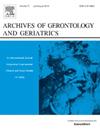老年人数字智能设备使用的流行程度及其影响因素:系统回顾和荟萃分析
IF 3.8
3区 医学
Q2 GERIATRICS & GERONTOLOGY
引用次数: 0
摘要
目的从全球角度探讨老年人数字智能设备(dsd)的使用情况及其影响因素。方法系统检索2011年1月1日至2025年4月16日Pubmed、Cochrane Library、Web of Science、Embase 4个数据库。两位研究人员进行了彻底的文献检索,收集了数据,并独立评估了文章的质量。进行亚组、敏感性和元回归分析以解决异质性。采用漏斗图和Egger检验评价发表偏倚。在筛选了36,405篇文章后,我们纳入了39项研究,涉及528,721名参与者。老年人使用dsd的总患病率为0.47 (95% CI: 0.39-0.54; p < 0.001)。较高的教育程度(OR = 2.00; 95% CI: 1.14-3.51; p < 0.05)和更积极的态度(OR = 2.37; 95% CI: 1.16-4.83; p < 0.05)与老年人使用dsd的可能性显著增加相关。然而,较高的年龄(OR = 0.85; 95% CI: 0.73-0.99; p < 0.05)与老年人使用dsd的显著减少相关。通过定性综合,共确定了13个影响dsd使用的其他因素。结论老年人dsd的使用程度适中,受年龄、文化程度和使用态度等多种因素的影响本文章由计算机程序翻译,如有差异,请以英文原文为准。
Prevalence and influencing factors of digital smart devices use among older adults: a systematic review and meta-analysis
Objective
This study aimed to explore the prevalence and influencing factors of digital smart devices (DSDs) use among older adults from a global perspective.
Methods
Systematic searches were conducted on four databases including Pubmed, Cochrane Library, Web of Science, and Embase from January 1, 2011 to April 16, 2025. Two researchers performed a thorough literature search, gathered data, and independently evaluated the quality of the articles. Subgroups, sensitivity, and meta-regression analyses were performed to address heterogeneity. Publication bias was evaluated using funnel plots and Egger’s test.
Results
After screening 36,405 articles, we included 39 studies encompassing 528,721 participants. The pooled prevalence of DSDs use among older adults was 0.47 (95 % CI: 0.39-0.54; p < 0.001). A higher educational attainment (OR = 2.00; 95 % CI: 1.14-3.51; p < 0.05) and a more positive attitude (OR = 2.37; 95 % CI: 1.16-4.83; p < 0.05) were associated with a significantly increased likelihood of DSDs use among older adults. However, a higher age (OR = 0.85; 95 % CI: 0.73-0.99; p < 0.05) was associated with a significantly reduced use of DSDs among older adults. A total of 13 other factors for DSDs use were identified through qualitative synthesis.
Conclusion
The prevalence of DSDs use among older adults is moderate and influenced by multiple factors, including age, education and attitude towards use
求助全文
通过发布文献求助,成功后即可免费获取论文全文。
去求助
来源期刊
CiteScore
7.30
自引率
5.00%
发文量
198
审稿时长
16 days
期刊介绍:
Archives of Gerontology and Geriatrics provides a medium for the publication of papers from the fields of experimental gerontology and clinical and social geriatrics. The principal aim of the journal is to facilitate the exchange of information between specialists in these three fields of gerontological research. Experimental papers dealing with the basic mechanisms of aging at molecular, cellular, tissue or organ levels will be published.
Clinical papers will be accepted if they provide sufficiently new information or are of fundamental importance for the knowledge of human aging. Purely descriptive clinical papers will be accepted only if the results permit further interpretation. Papers dealing with anti-aging pharmacological preparations in humans are welcome. Papers on the social aspects of geriatrics will be accepted if they are of general interest regarding the epidemiology of aging and the efficiency and working methods of the social organizations for the health care of the elderly.

 求助内容:
求助内容: 应助结果提醒方式:
应助结果提醒方式:


